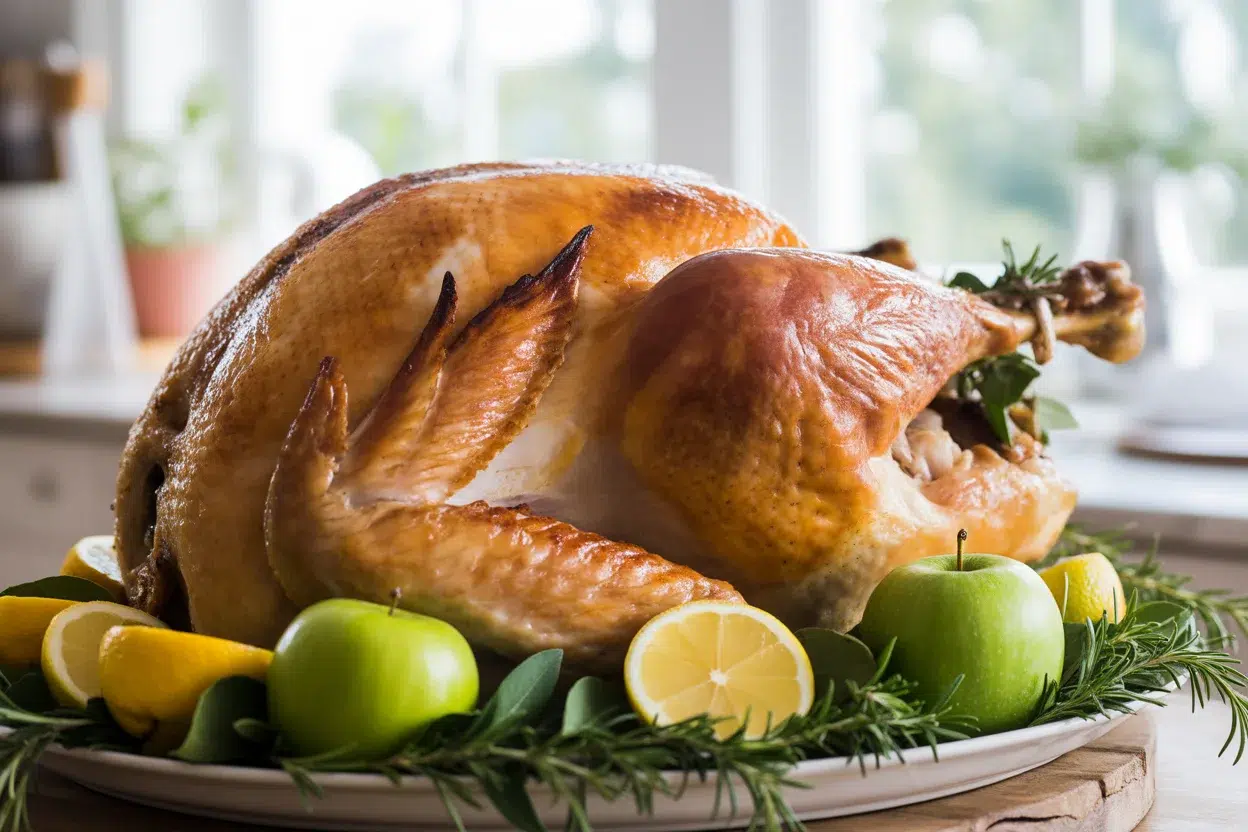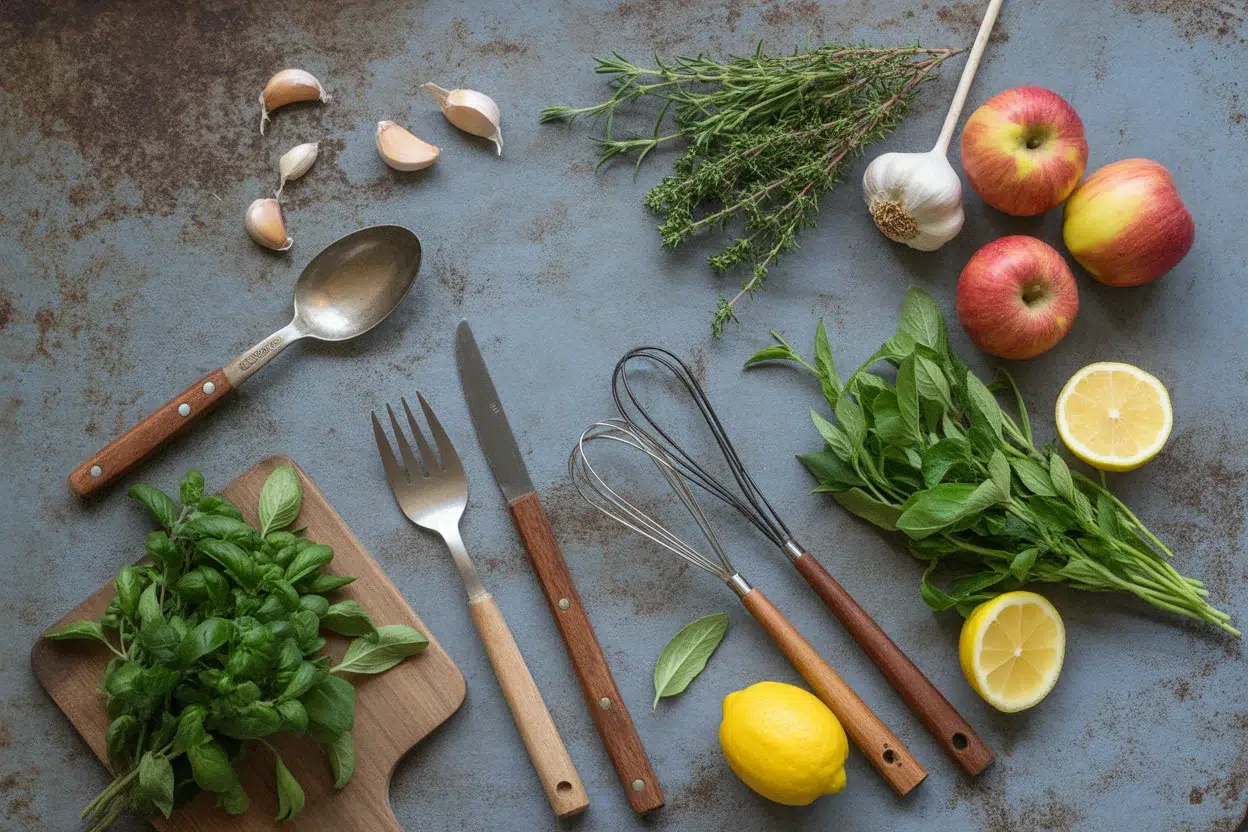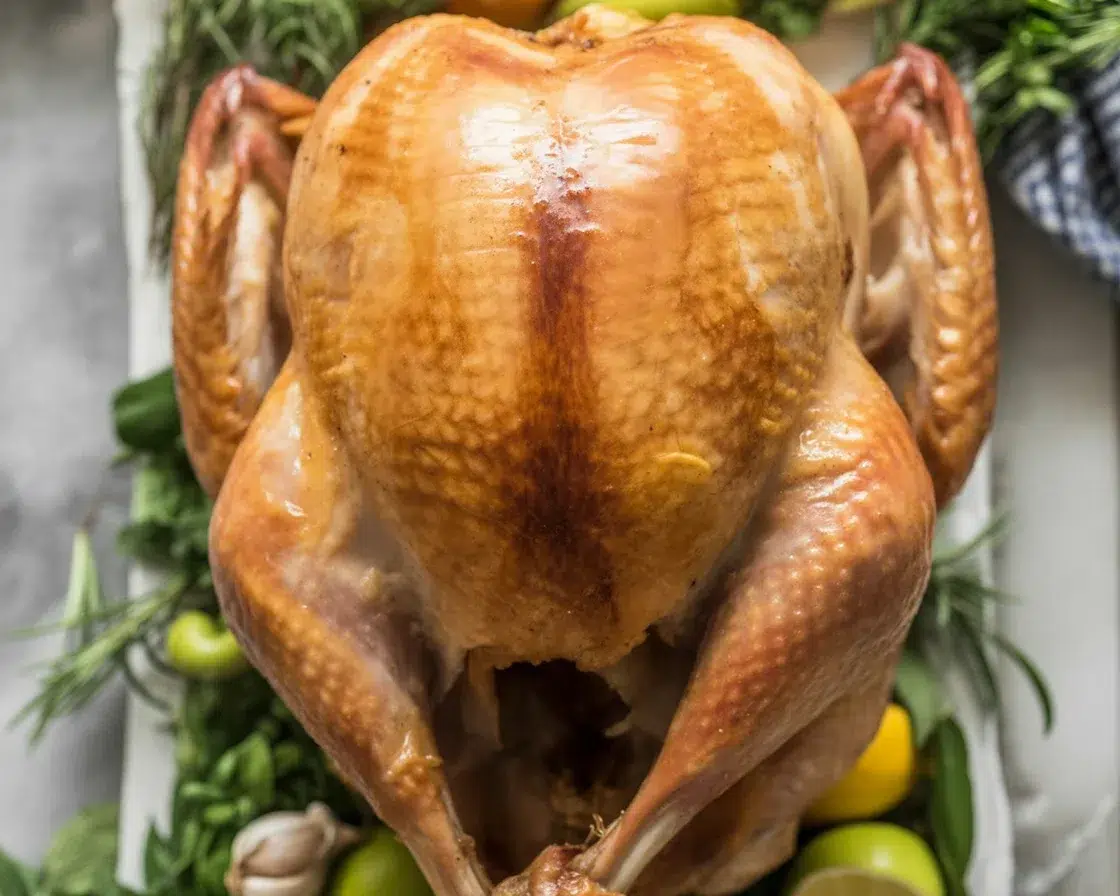thanksgiving turkey recipe stress is real. Maybe you hosted last year and the bird came out dry. Or you are cooking for the first time and feel nervous about timing, carving, and all the tiny details. I’ve been there. The good news is this guide is simple, friendly, and built for success. By the end, you’ll feel ready to make a turkey that’s juicy, flavorful, and so good people ask for seconds. 
Why You’ll Love This Turkey Recipe
Let’s keep it real. The holidays are busy enough. This method focuses on what matters: flavor, moisture, and a calm kitchen. You get crisp skin, tender meat, and a gravy-friendly pan without juggling fancy techniques. It’s approachable, and it works for small kitchens and big families.
I like a short ingredient list with big results. We lean on butter, garlic, lemon, fresh herbs, and salt. That’s it for the base. No complicated brines or equipment you have to hunt down. If it’s your first thanksgiving turkey recipe or your tenth, this approach hits that sweet spot of easy and impressive.
We also keep timing clear. No guessing when to baste or when to rest the bird. You’ll know how to plan the day, when to pop it in the oven, and how to check for doneness without panic. Think of me as your calm friend in the kitchen, talking you through it step by step.
Plus, this is a budget-friendly strategy. You’re not buying special rubs or tools. Just the basics you probably already have and a few fresh herbs to make the kitchen smell amazing. The result is a savory, classic centerpiece that makes the whole house feel cozy.
To help you compare key tips and cook times quickly, here is a planning helper.
Bottom line: this thanksgiving turkey recipe is practical, flexible, and really delicious. 
What Size Turkey to Buy?
Quick rule of thumb: plan on 1 to 1.5 pounds of turkey per person if you are buying a whole bird. If your crowd is big eaters or you want leftovers, aim closer to 1.5 pounds per person. Hosting a smaller group? A 10 to 12 pound turkey is perfect and easier to manage in most ovens.
If your group loves sandwiches on Friday, build that into your plan. A 14 to 16 pound turkey comfortably feeds 8 to 10 people with leftovers. For a duo or small gathering, consider a bone-in turkey breast so you still get that holiday moment without a mountain of extra meat.
Side note: a great turkey shines even brighter with the right sides. If you want a classic that never disappoints, try my favorite stuffing here: Grandma’s Thanksgiving stuffing. It’s rich, buttery, and perfect with gravy. 
Don’t Forget to Thaw The Turkey
Frozen turkey needs time. The safest way is thawing in the fridge. Plan one full day of thawing for every 4 to 5 pounds. So a 12 pound bird needs about 3 days in the fridge. Keep it in a tray to catch any drips, and do not let it sit at room temperature to thaw.
In a rush? Use the cold water method. Keep the turkey in its wrapper, submerge in cold water, and change the water every 30 minutes. This takes about 30 minutes per pound. Cook the turkey right after it’s thawed.
Food safety heads up: wash your hands often, keep the raw turkey away from fresh produce, and sanitize surfaces. For flavor guidance while you wait on thawing, you can skim through this helpful note on boosting taste without stress: how to make turkey taste good.
Equipment You’ll Need
You do not need a fancy setup. The basics work beautifully.
- Roasting pan with a rack, or a sturdy sheet pan with a rack
- Meat thermometer digital is best for accuracy
- Sharp knife and carving fork for serving
- Basting brush or spoon
- Aluminum foil for tenting if the skin browns too fast
- Small saucepan for a quick gravy
Optional but helpful
Kitchen twine to tie the legs together for even cooking, and a fat separator for smoother gravy. That is all.
How to Cook A Turkey
Ingredients
- 1 whole turkey, 10 to 16 pounds, thawed
- 1 cup unsalted butter, softened
- 1 tablespoon kosher salt, plus more to taste
- 2 teaspoons black pepper
- 1 head garlic, halved
- 1 lemon, halved
- Fresh herbs: thyme, rosemary, and parsley
- 1 onion, quartered
- 2 cups low sodium chicken or turkey broth, for the pan
Step by Step: The Simple Roasting Plan
- Bring the turkey to room temp: Take the turkey out of the fridge 45 to 60 minutes before roasting. Pat it dry with paper towels.
- Preheat the oven: Set to 325 F. Position a rack in the lower third so the turkey sits in the center of the oven.
- Season and butter: Mix softened butter with salt and pepper. Gently loosen the skin over the breast and rub some butter underneath. Rub the rest all over the outside. Season the cavity lightly with salt.
- Stuff for aroma: Place garlic, lemon, onion, and a handful of fresh herbs inside the cavity. This perfumes the meat without overpowering it.
- Tie and rack: Tie the legs with kitchen twine. Place the turkey on a rack in your pan. Pour broth into the pan to keep drippings from burning.
- Roast: Cook at 325 F until the thickest part of the thigh reaches 165 F. As a general guide, plan about 13 to 15 minutes per pound.
- Baste occasionally: Every 45 minutes, spoon pan juices over the skin. If it browns too quickly, tent with foil.
- Final check: Start checking the temp early. Insert the thermometer into the thickest part of the thigh without touching bone. Aim for 165 F in the thigh and about 160 F in the breast. The temp will climb a bit while resting.
- Rest: Transfer the turkey to a cutting board and let it rest, loosely tented with foil, for 30 minutes. This locks in the juices.
- Carve: Remove the legs and thighs first, then the breast meat, slicing against the grain into thick, tender slices.
Quick Gravy You Can Trust
Skim excess fat from pan drippings and set the roasting pan over medium heat across two burners if it fits, or pour drippings into a saucepan. Whisk in a tablespoon or two of flour until it looks smooth and lightly thickened, then splash in extra broth if needed. Season with a pinch of salt and pepper. If you want a smoother finish, strain it. That is your savory gravy, ready to go.
Little flavor tip: if you want to tweak the seasoning style, you can peek at ideas and spice riffs in this handy guide to better turkey flavor, again here for easy reference: how to make turkey taste good.
I followed this exact plan last year, and for the first time my turkey was juicy from edge to center. The instructions were calm and clear, and my family could not stop raving. It felt like a win I really needed.
Serving and Little Extras
Serve the carved turkey on a warm platter with sprigs of fresh herbs. A bright squeeze of lemon over the slices right before serving adds a hint of freshness. Round out the table with something sweet and seasonal. If you want ideas for the dessert spread, these picks are crowd favorites: desserts worth drooling over. The mix of creamy, crunchy, and chocolatey treats gives everyone a happy ending to the meal.
One more tip: save the carcass for stock. Simmer it the next day with onion, celery, carrots, and peppercorns. You will thank yourself in January when soup season really kicks in.
By the way, if you love classic sides, save this one for your menu planning too: Grandma’s Thanksgiving stuffing. It matches the flavor profile of this bird and soaks up gravy like a dream.
Common Questions
How do I keep the breast from drying out?
Rub butter under the skin, roast at 325 F, and do not skip the 30 minute rest. Checking the temperature early helps you avoid overcooking.
Should I brine the turkey?
You can, but it is optional with this method. The butter rub and gentle roasting temp keep the meat juicy. If you brine, reduce added salt in the recipe.
Do I need to baste?
Basting every 45 minutes adds shine and helps even browning. If you forget, it is not a deal breaker. The main key is not to overcook.
Can I stuff the turkey with bread stuffing?
For food safety and even cooking, I recommend baking stuffing separately. Warm it with some turkey drippings before serving for extra flavor.
What if my turkey is done early?
Tent with foil and keep it in a warm place. It stays hot for a while, and the rest period actually improves juiciness.
Ready To Cook A Stress-Free, Crowd-Pleasing Turkey?
You’ve got a clear plan, simple ingredients, and confidence on your side. This thanksgiving turkey recipe keeps the kitchen calm and the results consistent. If you want to compare with a few other trusted methods, these guides are helpful and beginner friendly: Easy, No-Fuss Thanksgiving Turkey – Tastes Better From Scratch, Easy Thanksgiving Turkey Recipe (Foolproof!), and Best Roasted Thanksgiving Turkey Recipe – How to Cook a Turkey.
Keep it simple, trust your thermometer, and give the bird its full rest. Your table is going to look and smell amazing. I hope this thanksgiving turkey recipe becomes a yearly favorite at your house. You’ve got this, and I am cheering you on from my kitchen to yours.

Thanksgiving Turkey
Ingredients
Method
- Bring the turkey to room temperature by taking it out of the fridge 45 to 60 minutes before roasting. Pat it dry with paper towels.
- Preheat the oven to 325°F (160°C). Position a rack in the lower third of the oven.
- Mix softened butter with salt and pepper. Loosen the skin over the breast and rub some butter underneath, then rub the rest all over the turkey.
- Season the cavity of the turkey lightly with salt.
- Stuff garlic, lemon, onion, and fresh herbs inside the turkey cavity.
- Tie the legs with kitchen twine and place the turkey on a rack in the roasting pan.
- Pour broth into the pan to keep drippings from burning.
- Roast the turkey at 325°F (160°C) until the thickest part of the thigh reaches 165°F (74°C).
- Plan for about 13 to 15 minutes of cooking time per pound.
- Baste the turkey every 45 minutes with pan juices.
- Start checking the temperature early to avoid overcooking. Aim for 165°F (74°C) in the thigh and about 160°F (71°C) in the breast.
- Transfer the turkey to a cutting board and let it rest for 30 minutes before carving.
- Skim excess fat from the roasting pan and set the pan over medium heat. Whisk in a tablespoon or two of flour until smooth and lightly thickened. Add extra broth if needed, and season with salt and pepper.
- Strain if you prefer a smoother gravy.
- Serve the carved turkey on a warm platter with fresh herbs and a squeeze of lemon.
- Pair with seasonal desserts for a complete meal.

